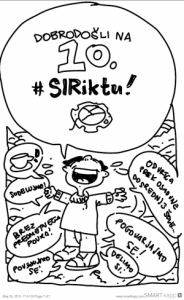Katja Gajšek, Osnovna šola Hruševec Šentjur, Šentjur
We often hear words like e-sources, e-textbooks, e-book … How about e-fairy tale? The students in the fifth grade that took part in the elective course Art have already learned how to make an animation, synchronize it, create movie editing and thus design an e-book with the help of older students. I decided that the students should combine their knowledge and make their first e-fairy tale. As a source material I used the fairy tale that was written by my mother Majda Kamenšek Gajšek. I also illustrated the fairy tale a few years ago. A film animation was planned together with the students. Then they produced the animation and voiceover in groups. Since there were many students in the class, we divided the story into different chapters so that each group could work on. But that wasn’t all. A colleague translated the story into German. The classmates then read and analysed the story in the elective German course. With the help of older students that have already learned how to make an e-book, they designed the story and animation in e-book form. That is how the e-fairy tale that contains animation and is actually bilingual was made. The purpose of the project was that the students combine their knowledge of the second language, art expression and technology and thus independently produce a very useful material for other students. E-fairy tale can be used as a reading material or as an aid in the learning process of the second language through storytelling. During animation the readers can read in both languages, Slovenian and German. They can also hear the pronunciation of words and understand the meaning of the story more easily. The students learned from each other all the time and they were active participants in the learning process. It is very important that there is a useful product at the end of the project so they can share it with the other students. Because this type of a group activity requires a lot of planning and coordination, I decided to use a story that was already written. In the future I see a big potential in such activities for the students to make their own e-fairy tales. At schools, the students can combine their interests and knowledge and work together, they learn how to collaborate in the process and become a team that can produce a unique e-fairy tale.
